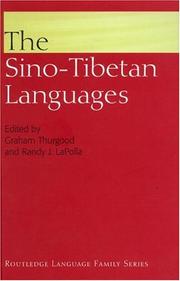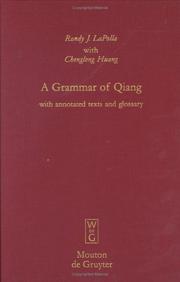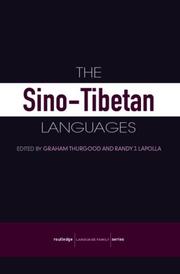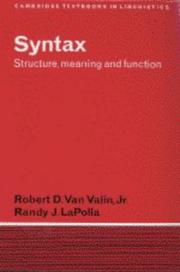| Listing 1 - 5 of 5 |
Sort by
|

ISBN: 0700711295 0415772958 9786610450749 1299140130 1135797188 1280450746 0203221052 Year: 2003 Publisher: London : Routledge,
Abstract | Keywords | Export | Availability | Bookmark
 Loading...
Loading...Choose an application
- Reference Manager
- EndNote
- RefWorks (Direct export to RefWorks)

ISBN: 1282193805 9786612193804 3110197278 9783110197273 9783110178296 311017829X 311017829X 9781282193802 6612193808 Year: 2003 Publisher: Berlin Mouton de Gruyter
Abstract | Keywords | Export | Availability | Bookmark
 Loading...
Loading...Choose an application
- Reference Manager
- EndNote
- RefWorks (Direct export to RefWorks)
This book is a full reference grammar of Qiang, one of the minority languages of southwest China, spoken by about 70,000 Qiang and Tibetan people in Aba Tibetan and Qiang Autonomous Prefecture in northern Sichuan Province. It belongs to the Qiangic branch of Tibeto-Burman (one of the two major branches of Sino-Tibetan). The dialect presented in the book is the Northern Qiang variety spoken in Ronghong Village, Yadu Township, Chibusu District, Mao County. This book, the first book-length description of the Qiang language in English, is the result of many years of work on the language, and is as typologically comprehensive as possible. It includes not only the reference grammar, but also an ethnological overview, several fully analyzed texts (mostly traditional stories), and an annotated glossary. The language is verb final, agglutinative (prefixing and suffixing), and has both head-marking and dependent marking morphology. The phonology of Qiang is quite complex, with 39 consonants at seven points of articulation, plus complex consonant clusters, both in initial and final position, as well as vowel harmony, vowel length distinctions, and a set of retroflexed vowels. The grammar also is complex, with a paradigm of eight direction marking verbal prefixes, and two paradigms for person marking, one for actor, one for non-actor, and a variety of other verbal prefixes and suffixes, as well as definite and number marking on nouns. Noun phrases take classifiers and relational pospositions as well.
Khyang language --- Asho Chin language --- Asho language --- Ashu language --- Aso language --- Chin language, Asho --- Khyeng language --- Kyang language --- Qin language --- Sho language (Bangladesh and Lower Burma) --- Shoa language --- Chin languages --- Grammar. --- Grammar --- Sino-Tibetan languages

ISBN: 9780415772952 Year: 2007 Publisher: London Routledge
Abstract | Keywords | Export | Availability | Bookmark
 Loading...
Loading...Choose an application
- Reference Manager
- EndNote
- RefWorks (Direct export to RefWorks)
Book
ISBN: 9789027204097 9027204098 9789027268730 9027268738 Year: 2015 Volume: 6 Publisher: Amsterdam, Netherlands ; Philadelphia, Pennsylvania : John Benjamins Publishing Company,
Abstract | Keywords | Export | Availability | Bookmark
 Loading...
Loading...Choose an application
- Reference Manager
- EndNote
- RefWorks (Direct export to RefWorks)
It is widely understood that the socio-historical contexts of languages have a direct bearing on their structures and on the types of stance that communities take in relation to them. Within the discipline of linguistics these socio-historical contexts and their impacts on communities' use and understanding of language are generally referred to as sociolinguistic factors. Meanwhile within descriptive linguistics the structure of language remains core. This is evidenced in the shape of university course design, structures of textbooks, and in how linguistic knowledge is recorded. In this paper
Sociolinguistics --- Structural linguistics --- Intercultural communication --- Sublanguage --- Language and culture --- Social aspects --- Research --- 800:316 --- Sociolinguistiek --- 800:316 Sociolinguistiek --- Language and languages --- Language and society --- Society and language --- Sociology of language --- Linguistics --- Sociology --- Integrational linguistics (Oxford school) --- Culture and language --- Culture --- Language for special purposes --- Restricted language --- Special language --- Discourse analysis --- Semantics --- Register (Linguistics) --- Cross-cultural communication --- Communication --- Cross-cultural orientation --- Cultural competence --- Multilingual communication --- Technical assistance --- Social aspects. --- Research. --- Sociological aspects --- Variation --- Anthropological aspects

ISBN: 0521499151 0521495652 1139166794 9780521499156 9780521495653 9781139166799 Year: 1997 Publisher: Cambridge Cambridge University Press
Abstract | Keywords | Export | Availability | Bookmark
 Loading...
Loading...Choose an application
- Reference Manager
- EndNote
- RefWorks (Direct export to RefWorks)
This book is an introduction to syntactic theory and analysis which can be used for both introductory and advanced courses in theoretical syntax. Offering an alternative to the standard generative view of the subject, it deals with the major issues in syntax with which all theories are concerned. It presents syntactic phenomena from a wide range of languages and introduces students to the major typological issues that syntactic theories must address. A generous number of exercises is included, which provide practice with the concepts introduced in the text and in addition expose the student to in-depth analysis of data from many languages. Each chapter contains suggestions for further reading which encompass work from many theoretical perspectives. A separate teaching guide is available.
Grammar, Comparative and general --- Semantics. --- Syntax. --- Semantiek --- Sémasiologie --- Syntaxis --- Syntaxis. --- 801.56 --- 801.56 Syntaxis. Semantiek --- Syntaxis. Semantiek --- Semantics --- Formal semantics --- Semasiology --- Semiology (Semantics) --- Comparative linguistics --- Information theory --- Language and languages --- Lexicology --- Meaning (Psychology) --- Syntax --- Lexicology. Semantics --- Grammar --- Syntaxe --- Sémantique --- Grammar [Comparative and general ] --- Linguistics. --- Arts and Humanities --- Language & Linguistics --- Linguistics --- Philology --- Grammar, Comparative and general - Syntax. --- Grammar, Comparative and general - Syntax --- Grammar, Comparative and general Syntax --- Anglais (langue) --- Linguistique --- Manuels
| Listing 1 - 5 of 5 |
Sort by
|

 Search
Search Feedback
Feedback About UniCat
About UniCat  Help
Help News
News